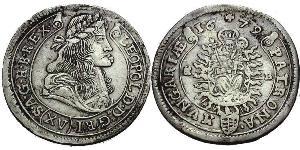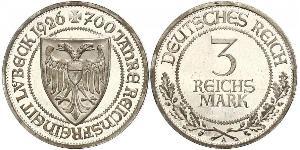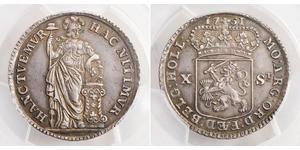(sold for $26.0)
1682, Emperor Leopold I "the Hogmouth". Silver 6 Kreuzer Coin. Graz mint!
Mint Year: 1682
Reference: KM-1288.
Ruler: Leopold I "the Hogmouth".
Denomination: VI Kreuzer (6 Kreuzer)
Mint Official: Johann Anton Nowak (1670-1694)
Condition: Corrosion scars, otherwise a nice VF+
Mint Place: Graz (Duchy of Styria)
Diameter: 26mm
Weight: 2.84gm
Material: Silver
Obverse: Wreathed, armoured and draped bust of Leopold I., right. Denomination numeral (VI) below.
Legend: LEOPOLDVS . D . G . R . (VI) I . S . A . G . H . B . R .
Reverse: Imperial crown above composite coat-of-arms with lion of graz in the upper middle. All within foliage and order collar.
Legend: ARCHID . AVS . . D . B . STYRIAE . 16 82
Comment: Mint Official´s initials (IAN) below.
Graz is the second-largest city in Austria after Vienna and the capital of the federal state of Styria. In the 14th century Graz became the city of residence of the Inner Austrian line of the Habsburgs. The royalty lived in the Schloßberg castle and from there ruled Styria, Carinthia, and parts of today's Italy and Slovenia (Carniola, Gorizia and Gradisca). In the 16th century, the city's design and planning were primarily controlled by Italian Renaissance architects and artists. One of the most famous buildings built in this style is the Landhaus. It was designed by Domenico dell'Allio, and was used by the local rulers as a governmental headquarters. Graz was also a city that famous astronomer Johannes Kepler lived in for a short part of his life. There, he worked as a math teacher, but found time to study astronomy. He left Graz to go to Prague when Lutheran people were banned from the city. Karl-Franzens Universität, also referred to as the University of Graz, is the city's oldest university, founded in 1585 by Archduke Charles II.
Leopold I, Holy Roman Emperor (name in full: Leopold Ignaz Joseph Balthasar Felician) Habsburg (June 9, 1640 – May 5, 1705), Holy Roman emperor, was the second son of the emperor Ferdinand III and his first wife Maria Anna of Spain. His maternal grandparents were Philip III of Spain and Margarita of Austria.
He was a younger brother of Ferdinand IV of Hungary and Mariana of Austria. Intended for the Church, he received a good education but his prospects were changed by the death of his elder brother Ferdinand IV, on July 9, 1654 of smallpox, when he became his father's heir.
Leopold was physically unprepossessing. Short and sickly, he had inherited the Habsburg lip to a degree unusual even in his inbred family. One contemporary said of him "His gait was stately, slow and deliberate; his air pensive, his address awkward, his manner uncouth, his disposition cold and phlegmatic".
In 1655 he was chosen king of Hungary and in 1656 king of Bohemia,1657 king of Croatia and in July 1658, more than a year after his father's death, he was elected emperor at Frankfurt in spite of the intrigues of Jules Cardinal Mazarin, who wished to place on the imperial throne Ferdinand Maria, Elector of Bavaria or some other prince whose elevation would break the Habsburg succession.
Mazarin, however, obtained a promise from the new emperor that he would not send assistance to Spain, then at war with France, and, by joining a confederation of German princes, called the league of the Rhine, France secured a certain influence in the internal affairs of Germany. Leopold's long reign covers one of the most important periods of European history; for nearly the whole of its forty-seven years he was pitted against Louis XIV of France, whose dominant personality completely overshadowed Leopold. The emperor was not himself a man of war, and never led his troops in person; yet the greater part of his public life was spent in arranging and directing wars. The first was with Sweden, whose king Charles X found a useful ally in the prince of Transylvania, György II Rákóczi, a rebellious vassal of the Hungarian crown.
This war, a legacy of the last reign, was waged by Leopold as the ally of Poland until peace was made at Oliva in 1660. A more dangerous foe next entered the lists. The Ottoman Empire interfered in the affairs of Transylvania, always an unruly district, and this interference brought on a war with the Holy Roman Empire, which after some desultory operations really began in 1663. By a personal appeal to the diet at Regensburg Leopold induced the princes to send assistance for the campaign; troops were also sent by France, and in August 1664 the great imperialist general, Raimondo Montecuccoli, gained a notable victory at Saint Gotthard. By the Peace of Vasvár the emperor made a twenty years' truce with the sultan, granting more generous terms than his recent victory seemed to render necessary.

|
Posted by:
anonymous 2016-02-12 |
1 Ducat Austria-Hungary (1867-1918) Gold Franz Joseph I (183 ...
group has 23 coins / 12 prices
⇑
10 Stuiver Netherlands Silver
group has 6 coins / 5 prices
⇑
















-300-150-WL5_AAEBP_sAAAEjIkLAPfNR.jpg)








